Herbicide Resistance: Development and Management
Guide A-616
Revised by Leslie Beck
College of Agricultural, Consumer and Environmental Sciences, New Mexico State University
Author: Extension Weed Specialist, Department of Extension Plant Sciences, New Mexico State University. (Print Friendly PDF)
Worldwide, herbicides remain the most efficient and widely used technology for large-scale weed control. Therefore, the widespread evolution of herbicide resistance in weed populations within intensive crop production systems is a major threat to the sustainability and profitability of cropping systems. The introduction of new herbicides and herbicide modes of action to replace those herbicides failing due to resistance is essential for weed management. However, the rate of introduction of new herbicide active ingredients for world agriculture has slowed dramatically, and herbicides with a new mode of action have not been developed and released for more than 30 years. This is due to the difficulty and high cost involved in discovering and developing new herbicides and herbicide modes of actions, and, as a result, new herbicide discovery and development will not occur at the rate required for proactive and reactive resistance management. Therefore, there is a strong imperative to use currently available herbicide resources in more sustainable ways (Walsh and Powles, 2004).
Scope of the Problem
To date, resistance to 23 classes of herbicides has been reported in 484 biotypes of 254 species (158 dicots, 96 monocots) worldwide (Heap, 2017). In New Mexico, there are currently two confirmed cases of herbicide-resistant weed biotypes: a kochia (Kochia scoparia), recently renamed as burningbush (Bassia scoparia) in February, 2016 (FEIS, 2016), biotype resistant to herbicides inhibiting acetohydroxyacid synthase (AHAS, also known as acetolactate synthase or ALS; Figures 1a–1c), and a Palmer amaranth (Amaranthus palmeri) biotype resistant to glyphosate (Heap, 2017; Figures 2a and 2b). Considering the widespread usage of glyphosate in the region (e.g., orchards, vineyards, industrial situations, and glyphosate-resistant crops [Roundup Ready crops]), the development of glyphosate resistance in prolific weeds such as Palmer amaranth is a threat to the future use of this important herbicide in agriculture. To date, 39 prominent weed species have developed resistance to glyphosate worldwide. In the United States, 17 weed species have developed resistance to herbicides. Many prominent species, including Palmer amaranth, tall waterhemp (Amaranthus rudis), common ragweed (Ambrosia artemisiifolia), giant ragweed (Ambrosia trifida), hairy fleabane (Conyza bonariensis), horseweed (Conyza canadensis), burningbush, Italian ryegrass (Lolium multiflorum), annual bluegrass (Poa annua), and johnsongrass (Sorghum halepense), have developed resistance to glyphosate in multiple states (Heap, 2017).
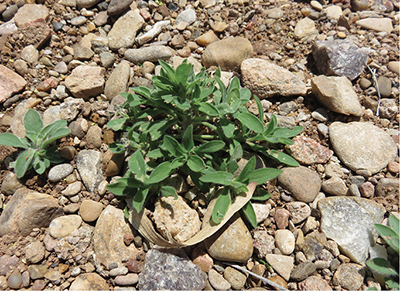
Figure 1a. Kochia (Kochia scoparia), recently renamed as burningbush (Bassia scoparia), is resistant to branched-chain amino acid inhibitors (acetolactate synthase [ALS] inhibitors) in New Mexico. Cross resistance and/or multiple resistance is common within the ALS inhibitors because it is the largest mode of action group.
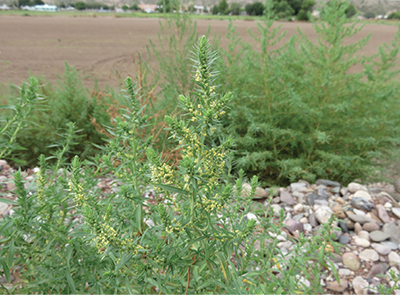
Figure 1b. Kochia (Kochia scoparia), recently renamed as burningbush (Bassia scoparia), is resistant to branched-chain amino acid inhibitors (acetolactate synthase [ALS] inhibitors) in New Mexico. Cross resistance and/or multiple resistance is common within the ALS inhibitors because it is the largest mode of action group.
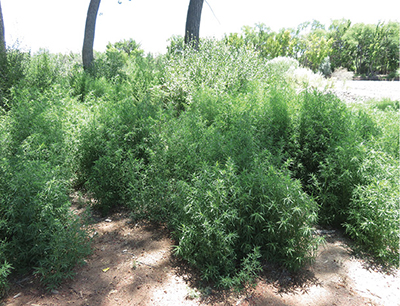
Figure 1c. Kochia (Kochia scoparia), recently renamed as burningbush (Bassia scoparia), is resistant to branched-chain amino acid inhibitors (acetolactate synthase [ALS] inhibitors) in New Mexico. Cross resistance and/or multiple resistance is common within the ALS inhibitors because it is the largest mode of action group.
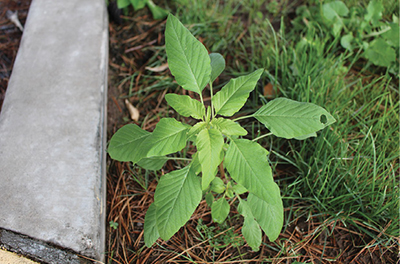
Figure 2a. Palmer amaranth (Amaranthus palmeri) has developed a resistance to aromatic amino acid synthesis inhibitors in New Mexico. Glyphosate is the only active ingredient with this mode of action.

Figure 2b. Palmer amaranth (Amaranthus palmeri) has developed a resistance to aromatic amino acid synthesis inhibitors in New Mexico. Glyphosate is the only active ingredient with this mode of action.
Resistance Definitions and Development
Herbicide resistance is the inherited ability of a plant to survive and reproduce following selection with a dose of herbicide normally lethal to the susceptible type of the plant. The development of herbicide resistance in weeds is an evolutionary process. Weed populations are extremely diverse genetically and can evolve very quickly. In some cases, the genetic variation within weed populations includes the inherent abilities to resist some herbicides; however, the frequency of such variation in a normal weed population is very low.
However, if an herbicide is applied repeatedly on the same weed population (or herbicides from the same herbicide group are applied) the entire picture can quickly change. As the majority of the susceptible biotypes are controlled after repeated applications, the few resistant biotypes are provided with a unique opportunity to proliferate. Therefore, using an herbicide (or herbicides from the same herbicide group) continuously for many years can drastically decrease the number of susceptible biotypes within the natural weed population and dramatically increase the number of resistant biotypes, causing a weed population shift. In response to widespread use of a particular herbicide mode of action (MOA), weed populations can change in genetic composition such that the frequency of resistance gene(s) and resistant individuals increases. Thus, weed populations become adapted to the intense selection imposed by herbicides (Jasieniuk et al., 1996).
Mechanisms of Herbicide Resistance in Weeds
In order to cause injury to a plant, an herbicide must be taken into the plant and moved (in lethal concentrations) to the specific site where it has activity (site of action). Metabolic and physiological changes within the plant can interfere with a lethal dose of the herbicide reaching its target site. These changes are referred to as the mechanisms of herbicide resistance in plants (Holt et al., 1993). Mechanisms of herbicide resistance in plants include an altered site of action, overproduction of the site of action, enhanced herbicide metabolism, decreased herbicide absorption and translocation, and herbicide sequestration. The most common mechanisms that cause herbicide resistance in weeds are altered site of action and enhanced herbicide metabolism. Alterations in the site of action that prevent the herbicide from binding are the most common mechanism of resistance (Heap and LeBaron, 2001). Enhanced herbicide metabolism is the superior ability of plants to convert the herbicide molecule to a form that is no longer toxic, whereas susceptible species are unable to detoxify the herbicide at the same rate as resistant species (Saari et al., 1994).
Types of Resistance
In some cases, resistant weeds have the ability to survive the application of types of herbicides other than the one to which they have developed resistance (i.e., the selecting herbicide). In such cases, resistant weeds are considered to have cross resistance or multiple resistance. Cross resistance occurs when one resistance mechanism (e.g., enhanced herbicide metabolism) allows the plant to withstand herbicides from different chemical classes. However, when a plant has multiple resistance it possesses two or more distinct resistance mechanisms (e.g., more altered sites of action plus enhanced metabolism), which allow the plant to resist herbicides from different chemical classes (Hall et al., 1994). For example, a population of smooth pigweed (Amaranthus hybridus) from Illinois has a multiple resistance to a photosynthesis-inhibiting herbicide and a sulfonylurea herbicide (two different modes of action), and a cross resistance to an imidazolinone and a sulfonylurea herbicide (two different chemistries within the same mode of action) (Maertens et al., 2004).
In some weeds, resistance to one herbicide results in increased susceptibility to another herbicide or other abiotic factors, such as standard cultivation practices, and/or biotic factors, such as effects of insect pests or infection by disease. This phenomenon is known as negative cross resistance (Gressel and Segel, 1990) and could be exploited in some resistant weed species. For example, Salhoff and Marton (1986) reported that triazine-resistant burningbush biotypes from Idaho were more sensitive to 2,4-D than susceptible biotypes.
Factors Affecting Rate of Resistance Development
Selection Pressure. Selection pressure is one of the most important determinants of resistance development. Major factors contributing to selection pressure include the efficacy of the herbicide and the frequency of use (Maxwell and Mortimer, 1994). In general, selection pressure is a measure of an herbicide’s ability to differentiate between susceptible and resistant plants. Therefore, herbicides with higher efficacy in the control of a specific weed population impose higher selection pressure for the resistant individuals among that weed population. Moreover, depending on the soil and herbicide chemical properties, herbicide residual activity could also be a major factor in the development of herbicide resistance (Jasieniuk et al., 1996; Beyer et al., 1988). This means that the selection pressure on susceptible weeds from herbicides with longer residual activities would be higher than that from herbicides with shorter or no residual activities.
Initial Frequency of Resistance Mutations. Precise studies have not been performed on the initial frequency of resistance mutations in weeds. However, some estimates have shown that approximately one out of a billion seeds from a population could be resistant (Harms and DiMaio, 1991). While these mutations are rare, large weed populations that are prolific seed producers can increase the likelihood that they might be present.
Gene Flow. Pollen and seed movement are the major methods of gene flow between and within plant populations (Maxwell and Mortimer, 1994). Furthermore, the spread of resistance occurs more rapidly in cross-pollinated species compared to self-pollinated species (Jasieniuk et al., 1996). Therefore, resistance genes most likely arise in an area through mutation, and gene flow would facilitate the spread of the resistance genes among individuals within that area (Jasieniuk et al., 1996; Ashigh et al., 2009).
Fitness. Fitness is a measure of survival and the ability of a given genotype (e.g., herbicide-resistant biotypes) to produce viable offspring in competition with the wild type (e.g., herbicide-susceptible biotypes) (Gressel, 2002). Although herbicide-resistant biotypes should be less fit than susceptible biotypes, depending on the mechanism of resistance and the environmental conditions, the fitness of resistant populations may vary. For example, under agricultural field conditions, triazine-resistant biotypes have been shown to be less fit than the susceptible biotypes, but many studies have not been able to detect fitness penalty (a detrimental impact on fitness) in biotypes resistant to AHAS inhibitors (e.g., Pursuit) under those conditions (Ashigh and Tardif, 2009). The existence of fitness penalty under field conditions could be exploited for management of those resistant biotypes affected by it.
Confirmation of Resistance
Resistant biotypes can be confused with weed escapes that result from herbicide failures caused by multiple factors, including climate, type and size of the weeds, herbicide selection/rate, equipment calibrations, or other factors that could lead to misapplications (Figures 3 and 4). However, herbicide resistance should not be suspected unless an herbicide failure fits within the following traits: (a) records indicate that the same herbicide was used year after year; (b) one weed, which normally should be controlled, is not controlled, although other susceptible weeds are; (c) a patch of one weed species that survived herbicide application is spreading; and (d) healthy weeds are mixed with controlled weeds of that same species. In cases where a control failure exhibits any of these traits, seeds of suspected herbicide-resistant weeds can be sent to the New Mexico State University Plant Diagnostic Clinic at the addresses below for confirmation of resistance.
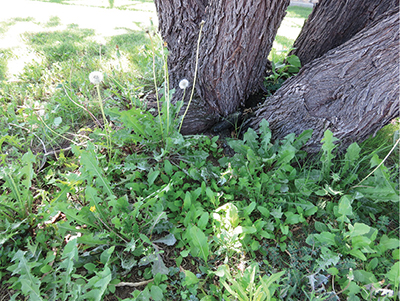
Figure 3. All weed management strategies must begin with accurate identification of the weed and its biology. Though many of the weeds in this image look similar, they each have different life cycles (i.e., annuals, biennials, and perennials) as well as different biological characteristics (warm- vs. cool-season weeds). Also, there are both broadleaves and grasses (monocots and dicots) in the image as well. Additionally, management practices must be adjusted to address the health and the safety of the tree in the photograph and its exposed roots. When utilizing herbicides, active ingredients should be chosen to successfully address the differences in each of the weeds, but herbicides with varying modes of action should also be utilized to reduce the development of resistance.
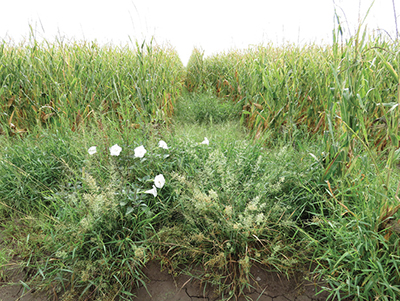
Figure 4. All weed management strategies must begin with accurate identification of the weed and its biology. One of the characteristics that should be considered for the timing of weed management is when the weed is young (germinating seedling if an annual) and when it is actively growing. Herbicide applications made during these two periods will improve successful management. The grower in this case has missed their window of opportunity with these weeds because the weeds are very mature, with flowers and seedheads. Herbicide applications will injure but not kill these weeds, allowing them to build up a tolerance to the herbicide mode of action over time.
Mailing address (USPS)
Plant Diagnostic Clinic
MSC 3AE
New Mexico State University
P.O. Box 30003
Las Cruces, NM 88003-8003
Shipping address (UPS or FedEx)
New Mexico State University
Attn: Plant Diagnostic Clinic
945 College Ave.
Skeen Hall, Room N140
Las Cruces, NM 88003-8003
Prevention and Management of Resistance
Because resistance is generally the consequence of using a single herbicide repeatedly, any proactive or reactive approach should take an opposite view. It is important to utilize an overall integrated pest management approach by combining as many of the following management practices as possible.
Identification. Most populations of resistant weeds do not become apparent to growers until at least 10 to 30% of the weed population has already developed resistance. Resistant populations can be identified with diligent field monitoring. Early detection and rapid response enables growers to contain and manage the resistance problem sooner and to employ preventative operational measures to control the spread of resistance.
Prevention. Once a resistance issue is identified, the problem can be contained with restricted movement of crops and equipment in an effort to minimize any relocation of contaminants. There have been cases where resistance was found in a field where previous practices should not have led to resistance. In such cases, introduction through harvesting equipment (custom combining) containing contaminants from the previous harvest could be the cause. Therefore, biosanitary practices, such as cleaning equipment and removing and destroying resistant plants to prevent re-infestation of the field with resistant seed or plant parts, should be employed.
Cultural Control. Weeds associated with cropping systems differ due to variances in the competitiveness and life cycles of specific crops. Crop rotations and/or use of competitive cover crops can work to suppress certain weed populations over time. Rotations may also permit the use of different chemicals (i.e., use of herbicides from different modes of action), fertilizers, and tillage programs to benefit the soil and future crops, and to suppress weed development.
Mechanical Control. Cultivation and hoeing can help provide weed control while reducing the reliance on chemical management. However, depending on the soil type, cultivation could increase the risk of soil erosion. Similarly, multiple cultivation events are not possible in perennial cropping systems, such as alfalfa. Similarly, the disturbance of the soil could potentially encourage weed seed germination.
Chemical Control. The use of herbicide rotations and mixtures is frequently advocated for resistance prevention and management. However, any rotations or tank mixes of different herbicides should include compounds with different modes of action that control similar spectra of weeds. They should possess the same persistence in the environment and degrade in different manners. Recent studies have shown that herbicide mixtures are superior to herbicide rotations in resistance prevention and management among weed populations. The idea behind the use of herbicide mixtures and/or rotations is to reduce the selection of resistant individuals in a weed population with a single herbicide or herbicide group.
Acknowledgments
Critical reviews of this article by Dr. François Tardif and Mr. Greg T. Bettmann are acknowledged.
References
Ashigh, J., and F.J. Tardif. 2009. An amino acid substitution at position 205 of acetohydroxyacid synthase reduces fitness under optimal light in resistant populations of Solanum ptychanthum. Weed Research, 49, 479–489.
Ashigh, J., I. Rajcan, and F.J. Tardif. 2008. Genetics of resistance to acetohydroxyacid synthase inhibitors in populations of eastern black nightshade (Solanum ptychanthum) from Ontario. Weed Science, 56, 210–215.
Beyer, E.M., M.J. Duffy, J.V. Hay, and D.D. Schleuter. 1988. Sulfonylurea herbicides. In P.C. Kearney and D.D. Kaufmann (Eds.), Herbicides: Chemistry, degradation, and modes of action (pp. 117–189). New York: Marcel Dekker.
Diggle, A.J., P.B. Neve, and F.P. Smith. 2003. Herbicides used in combination can reduce the probability of herbicide resistance in finite weed populations. Weed Research, 43, 371–382.
Fire Effects Information System (FEIS). 2016. Index of species information: Bassia scoparia [Online]. Retrieved February, 12, 2018, from https://www.fs.fed.us/database/feis/plants/forb/bassco/all.html.
Gressel, J. 2002. Molecular biology of weed control. New York: Taylor & Francis, Inc.
Gressel, J., and L.A. Segel. 1990. Modeling the effectiveness of herbicide rotations and mixtures as strategies to delay or preclude resistance. Weed Technology, 4, 186–198.
Hall, L.M., J.A.M. Holtum, and S.B. Powles. 1994. Mechanisms responsible for cross resistance and multiple resistance. In S.B. Powles and J.A.M. Holtum (Eds.), Herbicide resistance in plants, biology and biochemistry (pp. 243–263). Boca Raton, FL: Lewis Publishers.
Harms, C.T., and J.J. DiMaio. 1991. Primisulfuron herbicide-resistant tobacco cell lines: Application of fluctuation test design to in vitro mutant selection with plant cells. Journal of Plant Physiology, 137, 513–519.
Heap, I. 2017. International survey of herbicide resistant weeds [Online]. Retrieved December 17, 2017, from www.weedscience.org.
Heap, I., and H.M. LeBaron. 2001. Introduction and overview of resistance. In S.B. Powles and D.L. Shaner (Eds.), Herbicide resistance and world grains (pp. 1–22). Boca Raton, FL: CRC Press.
Holt, J.S., S.B. Powles, and J.A.M. Holtum. 1993. Mechanisms and agronomic aspects of herbicide resistance. Annual Review of Plant Physiology and Plant Molecular Biology, 44, 203–229.
Jasieniuk, M., A.L. Brulé-Babel, and I.N. Morrison. 1996. The evolution and genetics of herbicide resistance in weeds. Weed Science, 44, 176–193.
Maertens, K.D., C.L. Sprague, P.J. Tranel, and R.A. Hines. 2004. Amaranthus hybridus populations resistant to triazine and acetolactate synthase-inhibiting herbicides. Weed Research, 44, 21–26.
Maxwell, B.D., and A.M. Mortimer. 1994. Selection of herbicide resistance. In S.B. Powles and J.A.M. Holtum (Eds.), Herbicide resistance in plants, biology and biochemistry (pp. 1–27). Boca Raton, FL: Lewis Publishers.
Saari, L.L., J.C. Cotterman, and D.C. Thill. 1994. Resistance to acetolactate synthase inhibiting herbicides. In S.B. Powles and J.A.M. Holtum (Eds.), Herbicide resistance in plants, biology and biochemistry (pp. 141–170). Boca Raton, FL: Lewis Publishers.
Salhoff, C.R., and A.R. Marton. 1986. Kochia scoparia growth response to triazine herbicides. Weed Science, 34, 40–42.
Walsh, M., and S.B. Powles. 2004. Herbicide resistance: An imperative for smarter crop weed management. In Proceedings of the 4th International Crop Science Congress, Brisbane, Australia.
For further reading
A-325: Managing Weeds in Alfalfa
https://pubs.nmsu.edu/_a/A325/
A-617: Palmer Amaranth Biology and Management
https://pubs.nmsu.edu/_a/A617/
H-158: How to Collect and Send Specimens for Disease Diagnosis
https://pubs.nmsu.edu/_h/H158/

Leslie Beck is the Extension Weed Specialist at New Mexico State University. Her research program focuses on integrated weed management systems in landscape, horticultural, and agronomic crops. Her Extension work provides the citizens of New Mexico with accurate, applicable, and effective weed identification and management strategies in multiple cropping systems.
To find more resources for your business, home, or family, visit the College of Agricultural, Consumer and Environmental Sciences on the World Wide Web at pubs.nmsu.edu
Contents of publications may be freely reproduced for educational purposes. All other rights reserved. For permission to use publications for other purposes, contact pubs@nmsu.edu or the authors listed on the publication.
New Mexico State University is an equal opportunity/affirmative action employer and educator. NMSU and the U.S. Department of Agriculture cooperating.
Revised April 2018 Las Cruces, NM


